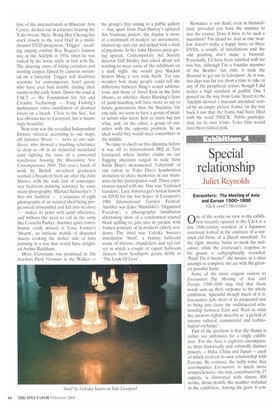Special relationship
Juliet Reynolds
Encounters: The Meeting of Asia and Europe 1500-1800 V&A, umil :5 December
("Nine of the works on view in the exhibi tion recently opened at the V&A is a late 18th-century woodcut of a Japanese courtesan locked in the embrace of a wizened old brute of a Dutch merchant. To the right, incense burns to mask his malodour, while the courtesan's response to his grunts is calligraphically recorded: 'Push! Do it harder!' she moans, in a clear attempt to complete the act with the greatest possible haste.
Some of the more exigent visitors to Encounters: The Meeting of Asia and Europe 1500-1800 may find that these words sum up their response to the whole exhibition. Splendid though much of it is, Encounters falls short of its purported aim to bring into focus the multifaceted relationship between East and West in what the curators rightly describe as 'a period of intense cultural, commercial and technological exchange'.
Part of the problem is that the theme is rather too ambitious for a single exhibition. For the Asia it explores encompasses three historically and culturally distinct powers — India, China and Japan — each of which evolved its own relationship with Europe. By contrast, the hefty tome that accompanies Encounters is much more comprehensive: the text, contributed by 27 experts, is illustrated with almost 400 works, about double the number included in the exhibition. Among the gems it con tains are miniature paintings from Rajasthan recording the erotic encounters between Europeans and Indian ladies. At least one of these should be on view in the V&A because they reflect an ethos or wit distinct from the Japanese that would add to the spectator's amusement and knowledge.
On the subject of miniature paintings and their display, the curators are found further wanting. The exhibition contains several miniatures, nearly all Indian, which even the non-specialist knows belonged to manuscripts intended for close and intimate spectatorship. But in most cases these are displayed in cases so deep that one is prevented from viewing them either whole or in detail. The earliest instance of this offence is a Mughal representation of the martyrdom of St Cecilia, a work of considerable artistic importance because it is based on a European engraving yet is distinctly Indian in expression; it is also finely executed. It would take a youngster with perfect vision to discern this, but since Encounters is unlikely to attract many such entities the very purpose of exhibiting it is defeated.
The curators, Anna Jackson and Amin Jaffer, are themselves relatively young and it is probably a lack of experience that underlies their lapses. And it is not that everything fails to make sense or offer pleasure in the viewing. For instance, several key works underline the superiority and blasé attitude of the Asian powers at the beginning of economic ties to Europe; among these are a painting of the Mughal emperor Shan Jahan receiving a European delegation, a wall-hanging illustrating the presentation of European gifts to China, and the richly painted screen depicting the arrival of Portuguese trading vessels in Japan.
The exhibits further highlight common ground when it comes to exotica. The European fascination for all things Asian — rare, novel and luxurious — is illustrated by a sumptuous display of objects in porcelain, ivory, mother of pearl and lacquer, as well as textiles, wallpaper and furniture. And the Eastern curiosity about Western innovations, such as clocks, telescopes and mirrors, is amply reflected in works of diverse materials and genres. One delightful example is a portrait on silk of the Chinese Emperor's cool and elegant concubine seated next to a jewel-inlaid European clock.
But when it comes to the representation of personal East–West encounters one begins to feel the need for greater depth. Of intrinsic interest are works like Joshua Reynolds's Captain John Foote in Mughal court dress or a portrait of the Yongzheng Emperor bewigged and attired according to Paris fashion. But these do not exlore human encounters. And here it must be pointed out that human relations between Europe and the Far East and Europe and India differed substantially in many ways,
in part because India had enjoyed ties with Europe way back in antiquity, in part because so many of the English fell in love with India and its people. Zoffany's warm portrayal of the Palmers, an Anglo–Indian family, reflects this special relationship. So do the portraits of an East India Company official and his bibi, or wife, both smoking hookahs, painted by an Indian artist of the 'Company School'. A greater emphasis on this aspect of encounters would be welcome.
So, too, would a less cursory examination of the artistic encounters between Asia and Europe. And this is specially true of India. here was a wonderful opportunity to look at the flowering of Mughal art under the patronage of the Emperor Jahangir. The fusion of indigenous, Persian and European techniques and styles that occurred in this era was to result in a considerable body of work in varied genres, the finest of which holds its own against the art of Europe. Instead, artistic encounters are represented by works of no particular merit such as Thomas Daniell's medley of Hindu and Muslim monuments and a view of a Japanese brothel in perfect perspeet lye.



















































































































 Previous page
Previous page